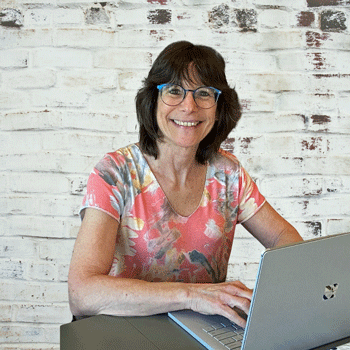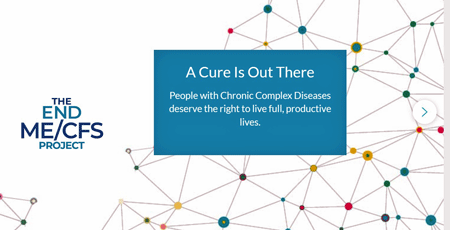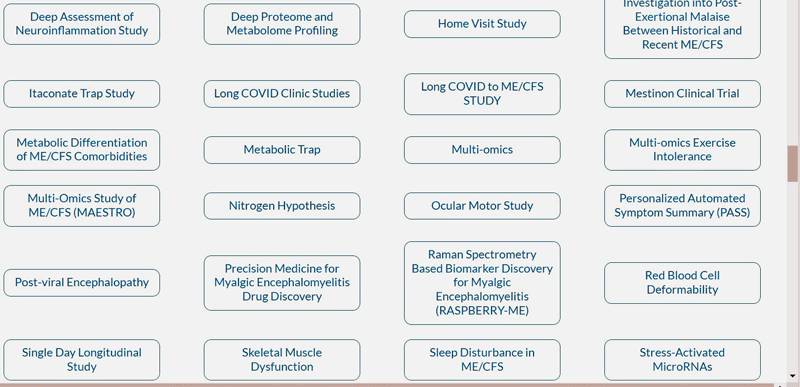

Sometimes we take things for granted. Take the Open Medicine Foundation (OMF). It’s been around for ten years now. It’s like an old friend. Of course, we have the Open Medicine Foundation!

Ten years ago, Linda Tannenbaum started the Open Medicine Foundation.
In truth, though, the OMF never had to happen and when it did, it didn’t have to succeed the way it has. Remember the Open Medicine Institute? It had a similar vision but failed. No other ME/CFS research organization has succeeded like the OMF has in its short life.
It took vision, commitment and probably some luck (:)) for the OMF to succeed the way it has. It also took one person to get it started and that person was Linda Tannenbaum. Spurred on by her daughter’s illness and shocked that so many sick people weren’t getting helped, she told me she took it on because someone had to. If no one else would, this former hospital administrator would, and so she did in 2012.
Two years later, the OMF got a big boost when Linda enrolled Ron Davis in her vision for the OMF. Davis, in turn, brought in connections galore and a cadre of experienced researchers – including two Nobel Prize winners – to join the effort. Still, the organization remained small, funding two research studies in 2015, adding 2 more in 2016, and 2 more in 2017. Things took off, though, after that. Five new studies in 2018 turned into 10 new ones in 2019, 2020, 2021, and 2022. The OMF currently has over 30 projects on its books.
This year it awarded over $5.5 million to 14 projects. With awards ranging for everything from muscle biopsies to neuroinflammation, to precision medicine, to metabolomics, it’s the most diverse ME/CFS research packet in existence.
The most exciting fact for me about the OMF, though, is not the fact that it’s done so well in a largely hostile medical environment, or the many interesting projects its funding, but in the ecosystem that it’s methodically built to support its work. That’s its secret sauce, and that’s what makes it unique amongst ME/CFS research efforts.
From 2014 onwards, the OMF has built out its capabilities – adding one new niche after another. Ron Davis’s ME/CFS Collaborative Research Center at Stanford introduced a molecular and technology core. The Ronald G. Tompkins Harvard ME/CFS Collaboration in 2014 secured a place at Harvard, no less, and added, with its invasive exercise studies, a focus on post-exertional malaise and muscle biopsy work. The ME/CFS Collaboration at Uppsala University in Sweden added a focus on neuroinflammation and cutting-edge technology in 2019. The two branches added in 2019: the ME/CFS Collaborative Research Center at the CHU Sainte-Justine Université de Montreal and the Melbourne ME/CFS Collaboration concentrated on provocation and multi-omics, and metabolism.
The roots of the whole enterprise came together in 2021 with the sixth research center – the Computational Collaborative Research Center – where data from all the other centers are stored and analyzed.
Ecosystems evolve over time to provide optimal energy, water, and nutrient flows which, in turn, build abundant, rich, and diverse systems. A good research ecosystem should do the same: it should quickly feed data from one part of the system to the other – enriching the whole. Nothing is wasted. Some things are naturally pruned back while others get more resources and grow.
Most individual research efforts, on the other hand, are siloed. Except for publication – which usually provides only a small part of the data – the data – the energy that drives medical research – is kept behind walls that keep it from enriching the whole. Like hardpans in the desert that stop roots from penetrating to the groundwater, these artificial silos prevent the field from optimally enriching itself – and finding cures for diseases.
Beta Testers Requested!
The Open Medicine Foundation’s ecosystem, on the other hand, is designed to facilitate the flow of data. Not only does everyone in its ecosystem – and some outside it – have access to the data, but the six teams in the OMF meet every two weeks to ensure that data produced by each researcher has the maximum opportunity to cross-fertilize with the others.
It’s this home-grown ecosystem that makes OMF’s projects – each quite enticing on its own – potentially so much more impactful. Inside the OMF ecosystem, for instance, the Harvard muscle biopsy study that’s assessing proteomics, metabolomics, phospho-proteomics, muscle structure, and “mito-biogenetics” has the opportunity to cross-fertilize with an invasive CPET study that’s assessing the inflammasome and proteomics studies done before, during, and after exercise.

Collecting data and finding connections to explain ME/CFS is what the OMF is all about.
The ecosystem approach is one reason we should celebrate the continuing growth of the Open Medicine Foundation ecosystem. Ecosystems tend to get stronger over time. The bigger they get – the more they reach their tendrils into the sky, into the soil, and into each other – the richer, more creative, and more diverse they get.
That’s why we should want the OMF ecosystem to continue to grow. The bigger it gets, the more potentially impactful it will be. Right now it features 31 remarkably creative studies. They are too numerous to cover but they range from an eye-tracking study that could provide a biomarker, to a rapid-fire day-long metabolomic and lipid sampling study, to one of my favorites – a spinal study that will assess craniocervical instability, cerebral spinal fluid pressure, and neuroinflammation.

Some of the studies on the OMF’s plate right now.
Linda Tannenbaum said she thought we’d have the answer by now. She’s not the first to underestimate the complexity and tenacity of ME/CFS. Ten years of work, though, has produced a rich ecosystem indeed – an ecosystem that will hopefully continue to grow and, as it does, become more productive. Who knows what wild and exotic flowers it might bloom?
The next branch to grow on the OMF’s tree – a search for repurposed drugs that can help now. More on that in 2023.
BIG (LIttle) Drive Update
Thanks to the over 320 people who have supported HR with over about $27,000 in donations!

Health Rising isnt just about itself; it also supports the organizations that are making a difference for people with ME/CFS/FM and long COVID. If that resonates with you please support us.
Health Rising is about more than communicating about the latest research and treatment options. A core goal involves supporting the people and organizations in the trenches who are, every day, creating opportunities to further ME/CFS/FM research.
In this blog, the 10th anniversary of the Open Medicine Foundation provided an opportunity to dig deeper into what that organization has done, and honestly, I was surprised at what I found. If learning about that enriched you, please support us.






i have donated many years to OMF but i finally want to see results. Many studys are verry small, treatments? yes low dose abilify treatment open acces small study , not double blind placebo controlled.
Later i thought they maybe had better studyd less different things with more money then being all over the place with almost no money.
first see and then believe!
even the big severelly ill study i do not know any results.
no, i have my hopes no more on OMF, we will see…
but only carmen scheibenbogen has gotten 10 miljons for clinical trials with old and new meds and research in cooperation with other hospitals to move fast forward. and then there is BC007 in germany to… that is more then i can say from OMF… and then the verry big decodeME study in the UK and presisionlife who has now a compagny to work together…
My understanding with the Severe ME/CFS study is that it did produce results that the OMF is following up with. There was one basic paper published but then the study just seemed to just kind of fade in the background. Given that study’s prominence, I think if a summing up hasn’t been done before it would be helpful to have one.
Of course, nothing is guaranteed in research. It seemed to make sense to do a deep dive into the most severely ill patients and if it didn’t work out – or didn’t work out to the extent that we hoped – that doesn’t mean it wasn’t a good idea or that they didn’t learn things along the way.
The Open Medicine Foundation has good researchers working for it, a highly motivated crew, an ace scientific board, a great infrastructure, and lots of interesting projects; it seems to be doing everything right. I would not at all give up on the OMF. I was shocked at how much they have going on.
hi cort, you wrote “Linda Tannenbaum said she thought we’d have the answer by now.”. it is totally not clear for me and stays with questions of what does she mean…
also “a search for repurposed drugs that can help now. More on that in 2023.” is not clear for me…
and what happened to the long ago mentioned sumarin, etc
with carmen scheibenbogen for excample, she simply says what and how… as far as she nows what meds, how everything will happen with the money, etc She is an open book like in Erlangen with BCOO7.
that i shurly miss with omf. And yes omf has much going on, to much in my opinion for the money they have… better a few studdys good and clinical trials good and animal models good then spreading the bit of money all over the place , no double blind placebo controlled trials, only most small studys, etc. It is just my opinion. Not that i want to say that scheibenbogen will find it for everyone or in erlangen but they are at least clear and want to move fast forward in further research and clinical trials and they name it. And scheibenbogen has at least the money for it, 20 miljon!
I do not entirely agree that the OMF conducts research in the wrong way. Small studies can lead to big results. In science, a well-conducted small study that achieves an objective result can lead to more money for a larger study.
In general, I also find the results of the past decades disappointing. You would expect that there would be a breakthrough one way or another. It indicates that ME/CFS/POTS/FM is a very complex disease. The ‘beast’ is difficult to find.
I would invest my money in autopsies, if i could. Lets say: study of 300 deceased ME/CFS/POTS/FM. That would have a lot of value (if you find something). But this is a difficult thing to do.
for me, i do not say that what omf wants to research is bad. But with everything they want, it would be ok if they had for excample 100 million… Or if there was at least a follow up in there tiny researchprojects with tons of money. But the tons of money are not there. It is like instead of buying 1 or 2 houses 20 houses or mere but only from each a half room or a cauch… and then i ask myself what is better? 2 whole houses (researchprojects where you can really do something with for excample) or all those cauches (tiny researchprojects with no serious follow up because there is no money)?
yes, autopsys are needed to. I am to ill to remember, who it was, wich country, etc was it dysautonomia international or ME/cfs or so. 3 autopsies where done and they found things in the brain… why would it not be possible if people die and want to give there boddy for research?
Hi Anonymous, was it this study by Bhupesh Prusty you were thinking about?
https://www.healthrising.org/blog/2022/12/15/prusty-hhv-6-brains-chronic-fatigue-syndrome/
Hi Tracey, i also think about Sophia Mirza.
https://me-pedia.org/wiki/Sophia_Mirza#:~:text=The%20coroner%20ruled%20that%20the,sensory%20cells%20displaying%20significant%20abnormalities.
I would also like more research into the liver, heart and vascular system. Through autopsy.
Thank you OMF!
Really exciting studies to come and glad there’s one about the eyes. I think that’s pretty understudied in general but a lot of people have eye issues with ME/CFS.
Its really interesting stuff. From a blog last year.
The project is already producing some very interesting findings indicating that some sort of pathology is present. Armstrong and collaborators hope to develop their findings into a diagnostic or objective marker for ME/CFS and its symptoms.
“The tool may even be able to pick up the early fatigability and exertion intolerance that occurs as the eyes (and brains) of people with ME/CFS tire over time. Thus far, Armstrong is finding, in contrast to healthy controls, that the eyes of people with ME/CFS get worse over time at following that dot – leading to the possibility that the Ocular Motor Project could lead to the first easy test for exertion intolerance.”
https://www.healthrising.org/blog/2021/10/17/chris-armstrong-chronic-fatigue-syndrome-metabolism/
We don’t got any treatment for bebridding fatigue!
I mean any symptom is managable with Medications but this fatigue?
I wish their “share the data” model existed at the CDC or in all research areas for that matter ! It eliminates re-inventing the wheel. Is seems that many researchers have no idea what has previously been described although their research does validate prior data. It’s encouraging to hear of their progress much like the “little engine that could” !!!!! Bravo ! Every little bit helps.
From what I can tell the NIH’s RECOVER project, at least, is proceeding in a similar way.
That’s great to hear !
Many thanks to all who are involved with the OMF. Years ago, I found one of their Symposium’s online and was so impressed with all these fascinating researchers. I came across Jarred Younger PhD, discussing his ideas about neuroinflammation and thought I would focus on an anti-inflammatory diet and other ways of trying to reduce inflammation in general. I will be forever grateful for the opportunity to hear him speak.